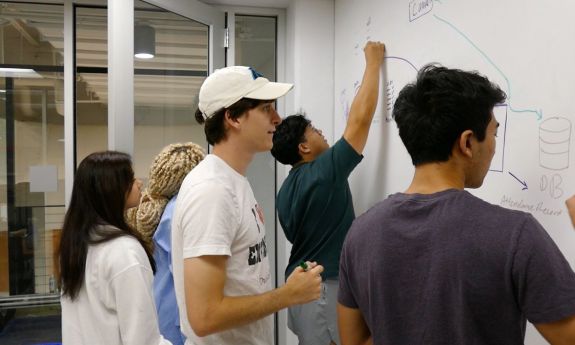Coding for Honeypots and Museums: Code+ Program Allows Students to Engage in Real-World Computer Problem-Solving

However, this year the program has been expanded beyond Duke’s campus. Working in conjunction with the Museum of Durham History, students are creating a “museum without walls,” which will allow it to use technology to provide programs and exhibits that present stories from a variety of voices and eras throughout Durham’s history.
Anna Zhang is one of the students exploring how to meet the museum’s objectives. A rising sophomore and computer science major, Zhang says she not only learned that has she walked by the museum many times without realizing it was there, but she also is learning a thing or two about website development.
“It’s not just making a pretty website, the part we are building is also going to be used for high-schoolers and students interested in learning about Durham history, so it will have an impact on education,” Zhang says.
Kelly Xu, a rising sophomore majoring in computer science and biomedical engineering, says Code+ is providing her with a sense of what it is like to be in the real-world solving technology-related problems.
“I think I have learned that there is more to computer science (CS) than what you learn in classes. That has been a motivating factor for me to go into CS instead of giving up on it,” she says.
Xu and her team are working on developing and prototyping honeypots -- a cybersecurity mechanism that attracts cybercriminals to a phony target to deflect them from legitimate information systems.
Will Neuner, another rising sophomore working on the honeypots project, says Code+ gives him valuable computer programming experience.
“We get the opportunity and time that you don’t get during the school year to dive into these topics many of us haven’t seen before,” Neuner says. “Code+ has opened that door for me and allowed me to be more comfortable with programming and being able to start and finish projects.”
Not only do the students work closely together for 10 weeks, but many also live together on campus at the Hallows Residence Hall.
“We are trying to build a vibrant living and learning community, so all of those who chose to live at Duke are living at the Hallows where they can build relationships that will take them through the rest of their time at Duke and beyond,” says Vizas.
Camaraderie is what Joyce Thomas, a rising sophomore who also is working on the honeypots project, says is the best part of her summer.
“It’s nice to know you have help, our mentors are there a lot and so are my other team members. None of us feel left behind. Teamwork is what I got out of it,” says Thomas.
Isabel Valls, the Code+ program manager is “the glue that holds it all together,” says Vizas. She makes sure the students have what they need to succeed, reminding them of where they need to be and what’s expected of them.
“We do weekly check-ins with the students every Friday. They get up and tell us where they are with their projects. Each also has a chance to present briefly so they get skilled at that,” Valls says.
Getting to know each student by name individually is particularly important to her.
“Students often ask us for recommendations, so I felt like I couldn’t speak about their experience without developing relationships with them. That’s why it’s important to sit down with each of the teams and get to know them a little more,” Valls says.
The experience often allows students to determine early in their academic lives what they like, or don’t like, about working in computer science.
James Mu, a rising sophomore, is a member of the Software Bills of Materials team, which deals with issues relating to software vulnerability and security.
“At the beginning of the program I was interested in front-end development – I liked making it pretty and functional,” says Mu. “But working with my team has made me realize that the front end is not the sole aspect of the user experience – having a clean back end so that the page loads quickly, and the app functions efficiently has been something I have come to realize and will continue to explore,” he says.
At the end of the 10 weeks, the project leads work with the stakeholders and the students to determine whether to continue the project.
“We might employ students to continue working on it throughout the next academic year, or we might build it out internally within OIT, or another unit might hire the students to work on it,” says Vizas. “It depends on the situation.”
Not only do the students get a great experience, but many of the IT professionals that participate as project leads and/or support the program say they also get a lot out of their involvement.
“OIT is a big organization, we have approximately 360 staff members. Code+ creates connections. They get to engage with students, and meet other staff they wouldn’t ordinarily meet,” Vizas says.